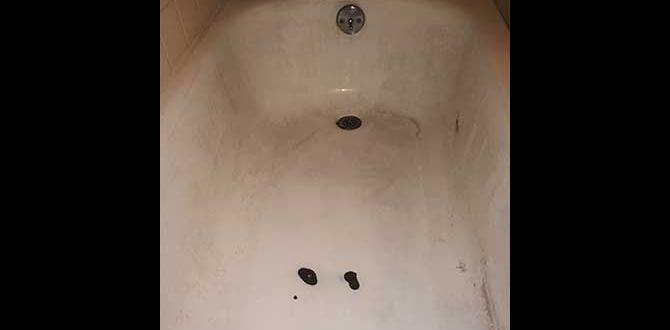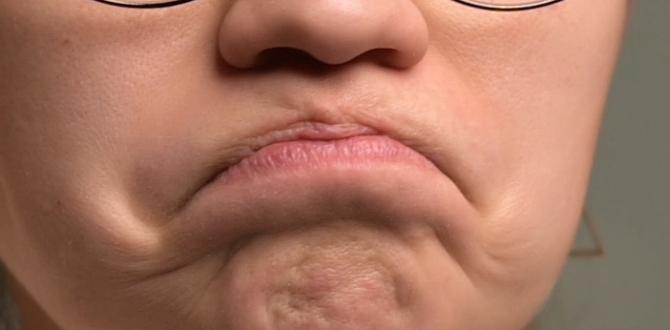Black sludge in your sink drain? It’s gross, but don’t worry! Usually, it’s just a mix of soap, hair, food, and bacteria. You can get rid of it easily. Start by flushing the drain with boiling water. Then, try baking soda and vinegar. For stubborn clogs, use a drain snake or enzymatic cleaner. Keep your drain clean by flushing it regularly!
Is your sink drain clogged with a nasty black sludge? It’s a common problem. This gunk is usually a mix of soap scum, food particles, hair, and bacteria. It can cause slow drains and bad odors. Don’t stress! You can fix this yourself with a few simple steps.
This guide will show you how to get rid of that black sludge for good. We’ll start with easy methods and move to stronger solutions if needed. By the end, your sink will be draining smoothly and smelling fresh again. Let’s get started!
What Causes Black Sludge in Sink Drains?
That black sludge isn’t just dirt. It’s a combination of things that build up over time. Understanding what causes it helps you prevent it from coming back.
- Soap Scum: Many soaps contain fats that react with minerals in water. This creates a sticky residue.
- Food Particles: Even with a drain strainer, small bits of food can get through. These decompose and add to the sludge.
- Hair: Hair easily gets caught in drains and traps other debris.
- Bacteria and Mold: These thrive in the moist, dark environment of your drain. They feed on the organic matter in the sludge, making it worse.
- Grease and Oils: These solidify as they cool, coating the inside of your pipes and trapping other debris.
Tools and Materials You’ll Need
Before you start, gather these supplies. Having everything ready will make the job easier and faster.
- Boiling Water: A kettle or pot to boil water.
- Baking Soda: A common household cleaner and deodorizer.
- White Vinegar: Another household staple that reacts with baking soda to break down sludge.
- Dish Soap: Helps to dissolve grease.
- Drain Snake or Auger: A flexible tool for removing clogs.
- Plunger: Can help dislodge blockages.
- Enzymatic Drain Cleaner: Uses enzymes to break down organic matter.
- Gloves: To protect your hands.
- Safety Glasses: To protect your eyes.
- Screwdriver: To remove drain parts if needed.
- Old Toothbrush: For scrubbing small parts.
Step-by-Step Guide to Removing Black Sludge
Follow these steps to get rid of that nasty black sludge. Start with the simplest methods and move on to stronger ones if needed.
Step 1: Flush with Boiling Water
This is the easiest first step. Boiling water can melt grease and loosen some of the sludge.
- Boil Water: Heat a kettle or large pot of water until it’s boiling.
- Pour Carefully: Slowly pour the boiling water down the drain. Be careful to avoid splashes.
- Repeat: Repeat this process a couple of times. Wait a few minutes between pours.
- Check the Drain: See if the water drains faster. If not, move on to the next step.
Step 2: Baking Soda and Vinegar
This is a classic DIY drain cleaner. The fizzing action helps break down the sludge.
- Pour Baking Soda: Pour about 1 cup of baking soda down the drain.
- Add Vinegar: Follow with 1 cup of white vinegar.
- Let it Fizz: Let the mixture fizz for 30 minutes. Cover the drain with a plug or cloth to contain the fizz.
- Flush with Hot Water: After 30 minutes, flush the drain with hot water for several minutes.
- Repeat if Needed: If the drain is still slow, repeat this process.
Safety Tip: Always wear eye protection when working with chemicals like vinegar, even though it is mild. If you get any in your eyes, flush immediately with plenty of water.
Step 3: Dish Soap and Hot Water
Dish soap can help cut through grease and grime. This method is good for maintenance and mild clogs.
- Pour Dish Soap: Squirt a generous amount of dish soap down the drain.
- Add Hot Water: Follow with a pot of hot (but not boiling) water.
- Let it Sit: Let the mixture sit for about 15-20 minutes.
- Flush with Hot Water: Flush the drain with hot water for several minutes to clear away loosened debris.
Step 4: Use a Plunger
A plunger can create suction to dislodge clogs. This works best if there’s standing water in the sink.
- Add Water: If there’s no standing water, add enough to cover the cup of the plunger.
- Position the Plunger: Place the plunger over the drain opening, making sure to create a tight seal.
- Plunge Vigorously: Push and pull the plunger up and down vigorously for several minutes.
- Remove the Plunger: Lift the plunger to see if the water drains.
- Repeat if Needed: Repeat the plunging process several times until the drain clears.
Step 5: Clean the P-Trap
The P-trap is the curved pipe under your sink. It often traps debris. Cleaning it can remove a major source of sludge.
- Prepare a Bucket: Place a bucket under the P-trap to catch water.
- Loosen the Slip Nuts: Use a wrench or your hands to loosen the slip nuts on both sides of the P-trap.
- Remove the P-Trap: Carefully remove the P-trap, dumping the contents into the bucket.
- Clean the P-Trap: Rinse the P-trap with water and remove any debris. Use an old toothbrush to scrub if needed.
- Reassemble: Reattach the P-trap, tightening the slip nuts. Make sure they are snug but not too tight.
- Run Water: Run water to check for leaks. Tighten the nuts further if needed.
Tip: Take a picture of the P-trap before you disassemble it. This will help you remember how to put it back together.
Step 6: Use a Drain Snake or Auger
A drain snake can reach further into the drain to break up or remove stubborn clogs.
- Insert the Snake: Insert the drain snake into the drain opening.
- Feed it In: Push the snake further into the drain, rotating the handle as you go.
- Break Up the Clog: When you feel resistance, continue rotating the snake to break up the clog.
- Remove the Snake: Slowly pull the snake out of the drain, cleaning off any debris as you go.
- Flush with Water: Flush the drain with hot water to clear away any remaining debris.
Step 7: Enzymatic Drain Cleaner
Enzymatic cleaners use enzymes to break down organic matter. They are a gentler alternative to chemical drain cleaners.
- Follow Instructions: Read and follow the instructions on the enzymatic drain cleaner.
- Pour into Drain: Pour the recommended amount of cleaner down the drain.
- Let it Sit: Let it sit for the recommended time, usually overnight.
- Flush with Water: Flush the drain with water in the morning.
Caution: Avoid using chemical drain cleaners as a first resort. They can damage your pipes and are harmful to the environment. If you do use them, follow the instructions carefully and wear appropriate safety gear.
Preventing Black Sludge Buildup
Preventing sludge is easier than removing it. Here are some tips to keep your drains clean.
- Flush Regularly: Flush your drain with hot water after each use.
- Use a Drain Strainer: A strainer catches hair and food particles. Clean it regularly.
- Avoid Grease: Don’t pour grease or oil down the drain. Dispose of it in the trash.
- Baking Soda and Vinegar: Use the baking soda and vinegar method monthly as a preventative measure.
- Enzymatic Cleaner: Use an enzymatic drain cleaner periodically to break down organic matter.
Choosing the Right Drain Cleaner
There are many drain cleaners on the market. Here’s a comparison of different types:
| Type of Cleaner | Pros | Cons | Best For |
|---|---|---|---|
| Boiling Water | Simple, free, and safe. | Only effective for minor grease clogs. | Preventative maintenance. |
| Baking Soda and Vinegar | Natural, inexpensive, and effective for many clogs. | Can be messy, may not work on severe clogs. | General cleaning and mild clogs. |
| Enzymatic Cleaners | Eco-friendly, safe for pipes, and effective on organic matter. | Slower acting, may not work on inorganic clogs. | Regular maintenance and preventing buildup. |
| Chemical Cleaners | Fast-acting and effective on severe clogs. | Harsh, can damage pipes, and harmful to the environment. | Last resort for severe clogs. |
| Drain Snake | Effective for removing physical blockages. | Requires some effort, can be difficult to maneuver. | Hair and solid debris clogs. |
When to Call a Professional Plumber
Sometimes, DIY methods aren’t enough. Here’s when you should call a professional plumber:
- Persistent Clogs: If you’ve tried multiple methods and the drain is still clogged.
- Recurring Clogs: If clogs keep coming back.
- Slow Drains Throughout the House: This could indicate a problem with your main sewer line.
- Foul Odors: If you smell sewer gas, there could be a serious plumbing issue.
- Leaking Pipes: If you notice any leaks around your drain pipes.
Safety Precautions
Always take safety precautions when working on plumbing. Here are some important tips:
- Wear Gloves: Protect your hands from bacteria and chemicals.
- Wear Safety Glasses: Protect your eyes from splashes.
- Ventilation: Work in a well-ventilated area.
- Avoid Mixing Chemicals: Never mix different drain cleaners. This can create dangerous fumes.
- Protect Surfaces: Cover your work area to protect it from spills.
- Supervise Children and Pets: Keep children and pets away from the work area.
Troubleshooting Common Issues
Sometimes things don’t go as planned. Here are some common issues and how to solve them:
- Drain Still Clogged After Baking Soda and Vinegar: Try repeating the process or using a drain snake.
- P-Trap Leaks After Reassembly: Make sure the slip nuts are tightened properly. You may need to replace the washers.
- Drain Snake Won’t Go Down: Try rotating the snake in the opposite direction. You may need a different type of snake.
- Chemical Drain Cleaner Didn’t Work: Call a plumber. The clog may be too severe for DIY methods.
Cost Considerations
DIY drain cleaning is usually very affordable. Here’s a breakdown of potential costs:
| Item | Estimated Cost |
|---|---|
| Baking Soda | $1 – $3 |
| White Vinegar | $1 – $3 |
| Dish Soap | $1 – $5 |
| Drain Snake | $10 – $30 |
| Enzymatic Drain Cleaner | $10 – $20 |
| Plumber Visit | $100 – $300+ |
As you can see, DIY methods are much cheaper than calling a plumber. However, if you can’t solve the problem yourself, a plumber is a worthwhile investment to prevent further damage.
Frequently Asked Questions
What is the black stuff coming out of my drain?
That black sludge is usually a mix of soap scum, hair, food particles, and bacteria that builds up over time in your drain pipes.
Is black sludge in the drain dangerous?
While not immediately dangerous, the sludge can harbor bacteria and mold. It can also cause unpleasant odors and slow draining.
Can I use bleach to get rid of black sludge?
Bleach is not recommended. It can damage your pipes and doesn’t effectively break down the organic matter in the sludge. It can also react with other chemicals to create toxic fumes.
How often should I clean my sink drain?
You should clean your sink drain at least once a month to prevent buildup. Regular flushing with hot water and a monthly baking soda and vinegar treatment can help.
Will a drain strainer prevent black sludge?
A drain strainer helps a lot by catching hair and food particles. This reduces the amount of organic matter that can contribute to sludge buildup.
Are enzymatic drain cleaners safe for all types of pipes?
Yes, enzymatic drain cleaners are generally safe for all types of pipes because they use natural enzymes to break down organic matter without corroding your pipes.
Can I use a pressure washer to clean my drain?
While there are pressure washer attachments for cleaning drains, it’s best to avoid this unless you’re a professional. The high pressure can damage your pipes if not used carefully.
Conclusion
Getting rid of black sludge in your sink drain might seem gross, but it’s a task you can definitely handle yourself! By following these simple steps, you can clear your drains, eliminate odors, and keep your plumbing running smoothly. Start with the easy methods like boiling water and baking soda, and work your way up to stronger solutions if needed. Remember to take safety precautions and prevent future buildup with regular maintenance.
Don’t be discouraged if the first method doesn’t work. Sometimes it takes a combination of approaches to tackle stubborn clogs. And if you’re ever in doubt, don’t hesitate to call a professional plumber. With a little effort, you can keep your sink drains clean and fresh, making your home a more pleasant place to be!



